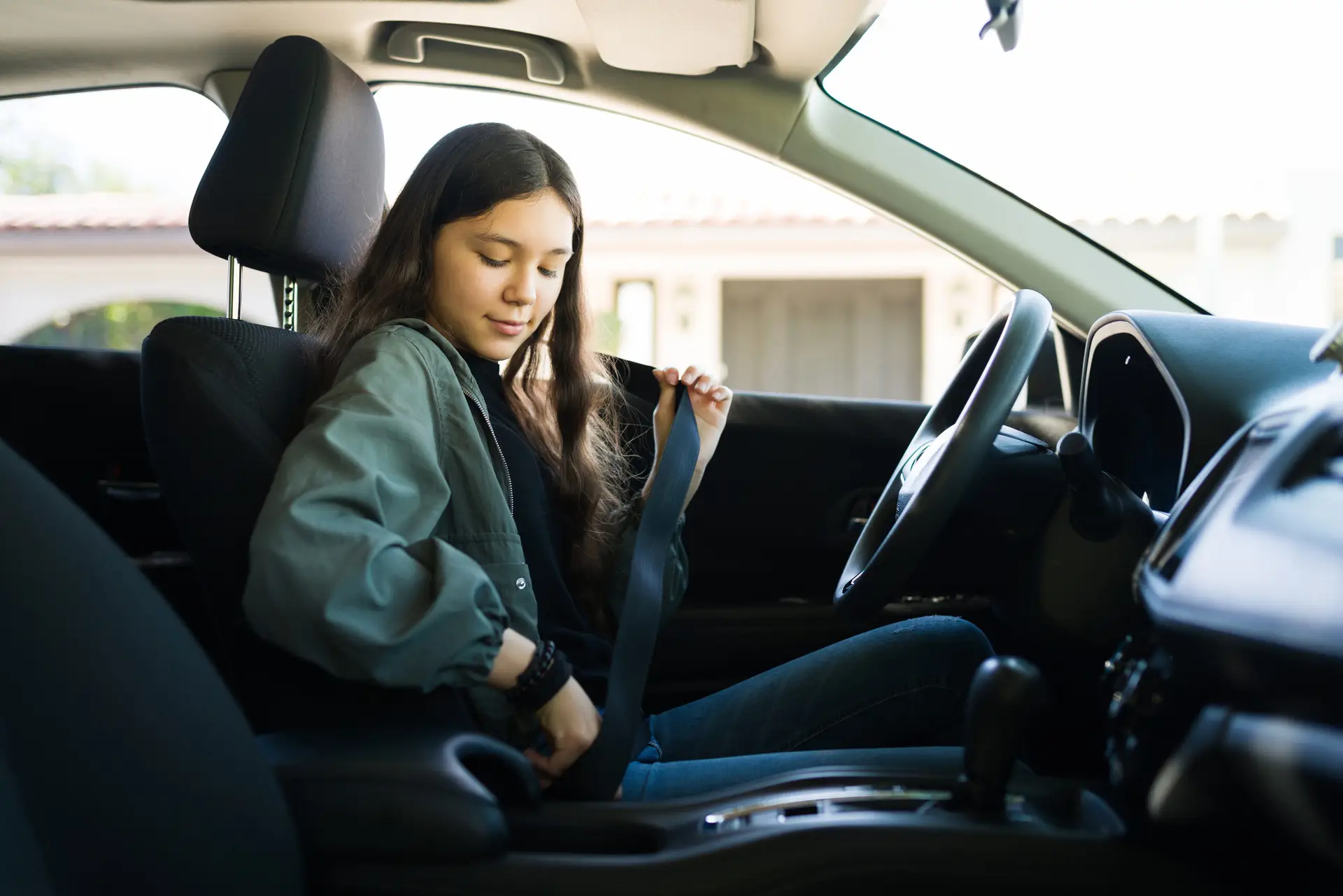Teen drivers are almost three times more likely to get in a crash than other drivers, making them a higher risk on the road. They’re also more likely to die in a car accident, as teenage drivers represent only 5% of all licensed drivers but accounted for 9% of all driver deaths in 2022. Learning about the most common types of car accidents, why teenagers are more likely to get in an accident, and ways to avoid teen driving accidents can help with crash avoidance and make the roads safer for everyone.
What Are the Most Common Teen Driver Accidents?
Teen drivers are more prone to certain types of accidents than others due to their inexperience and susceptibility to distractions. Both age and experience are negatively correlated with crash rates, meaning that the higher the age and the more experience a driver has, the lower the crash rate. Understanding these common accidents can help teens and their parents focus on developing specific skills and awareness to prevent them. These are some of the most common types of accidents involving teenage drivers:
- Rear-end collisions: These are the most frequent accidents for teen drivers. They happen because inexperienced drivers follow too closely behind or get distracted, preventing them from reacting quickly when the vehicle ahead slows or stops. Inexperience in judging proper following distances and stopping times also contributes to these crashes.
- Single-vehicle crashes: These accidents involve no other vehicles and are particularly common among teens. They tend to happen because inexperienced drivers struggle with the vehicle’s dimensions and end up clipping a curb, sign, or light pole. They also happen from poor-decision making, like speeding or overcorrecting after drifting off the road.
- Intersection accidents: Teens often get in accidents at intersections due to failure to yield the right of way or misjudging the speed of oncoming traffic. These accidents happen when distracted or overconfident teens run a red light or stop sign.
- Lane-change collisions: These happen when teens fail to check their blind spots or signal properly before changing lanes. Inexperience in judging the speed and distance of other vehicles and a lack of awareness about proper lane-change procedures contribute to these crashes.
- Parking lot collisions: While these tend to happen at lower speeds and typically don’t cause injuries, parking lot accidents are very common among teenage drivers. These come from inexperience maneuvering in tight spaces, failure to check surroundings adequately, or distraction. Even at low speeds, these accidents can cause significant property damage and result in higher insurance rates.
What Are the Primary Reasons for Teen Driver Crashes?
Teen drivers face unique challenges that contribute to their higher crash rates compared to more experienced drivers. The most common causes of teen driving accidents include:
- Inexperience: New drivers need to gain the skills to recognize and respond to potential hazards quickly. They often struggle with complex driving tasks like merging or navigating busy intersections, leading to poor decision-making in critical situations.
- Distracted driving: Teens are particularly susceptible to distractions, especially from smartphones. texting, social media use, and other phone-related activities while driving, which significantly increase crash risk. Other distractions like eating, adjusting music, or interacting with passengers also contribute to these accidents.
- Speeding: Teenage drivers often underestimate the dangers of speeding. They need more experience to judge how exceeding the speed limit poses a risk to themselves and others and how different road conditions affect safe driving speeds.
- Impaired driving: Despite this being illegal, some teens still drive under the influence of alcohol or narcotics. Their inexperience with both driving and the effects of substances makes this combination extremely dangerous.
- Night driving: Teen crashes increase significantly at night. In fact, just under half of all teenage motor vehicle crash deaths happen between 9 p.m. and 6 a.m., according to the Insurance Institute for Highway Safety. Reduced visibility, fatigue, and a higher likelihood of encountering impaired drivers contribute to this increased risk.
- Peer pressure and passenger distractions: Peer pressure can lead to risky behaviors, while passengers can be a major source of distraction. Taking the driver’s attention away from the road can quickly result in a catastrophic accident.
- Overconfidence: Some teens overestimate their driving abilities and underestimate road risks. This can lead to taking unnecessary chances, ignoring traffic laws, or driving beyond their skill level.
What Training Is Available for Teen Drivers?
Proper training can help teen drivers develop safe and responsible driving habits. There are many educational programs and resources to help young drivers gain the skills, knowledge, and experience necessary to navigate the roads safely, including:
- Driver’s education courses: These traditional classroom and behind-the-wheel programs form the foundation of teen driver training. They cover traffic laws, safe driving techniques, and basic vehicle operation. Many states require completion of a driver’s education course before teens can obtain their learner’s permit or license.
- Graduated driver licensing (GDL) programs: GDL systems are designed to gradually introduce driving privileges, allowing teens to gain experience under lower-risk conditions. These programs typically involve three stages: learner’s permit, intermediate license, and full license. Each stage has specific restrictions and requirements, such as supervised driving hours, passenger limits, and nighttime driving descriptions. Studies have found that GDL programs can reduce crash rates by up to 25%.
- Defensive driving courses: These specialized courses go beyond basic driver’s education, focusing on anticipating and avoiding dangerous situations on the road. They teach advanced techniques for hazard recognition, proper vehicle handling, and decision-making in high-pressure situations.
- Online resources and simulators: Online courses, interactive modules, and driving simulators offer supplementary training options for teen drivers. These resources can provide additional practice in a safe, controlled environment, allowing teens to experience many driving scenarios and conditions without real-world risks. While not a replacement for on-the-road experience, these tools can improve driver preparedness.
What Are the State Laws and Driving Requirements for Teen Drivers?
State laws and driving requirements shape teen driving practices and safety. While there are similarities across states, specific requirements can vary.
What Are the Louisiana Requirements for Teen Drivers?
Louisiana follows a GDL system for teen drivers. According to Louisiana Revised Statutes 32:405.1 and 32:407, the process includes:
- Learner’s permit: At age 15, teens can obtain a learner’s permit after completing a 30-hour driver’s education course. They must hold this permit for at least 180 days and complete 50 hours of supervised driving.
- Intermediate license: At 16, teens can get an intermediate license if they’ve held a learner’s permit for at least six months and passed a road skills test. Restrictions include no driving between 11 p.m. and 5 a.m. unless accompanied by a licensed adult and limitations on passengers.
- Full license: At 17, teens can obtain a full license if they’ve held an intermediate license for at least 12 months with no violations.
What Are the Texas Requirements for Teen Drivers?
Texas also uses a GDL system, according to the Texas Transportation Code, Chapter 521. The system includes:
- Learner’s permit: At 15, teens can get a learner’s permit after completing the classroom portion of a driver’s education course. They must complete 30 hours of behind-the-wheel training, including 10 hours at night.
- Provisional license: At 16, teens can obtain a provisional license if they’ve held a learner’s permit for at least six months and completed driver’s education. Restrictions include no driving between midnight and 5 a.m. unless necessary for work, school, or emergencies, and passenger limitations.
- Full license: At 18, teens are eligible for a full license without restrictions.
What Tips Can Help Teen Drivers Stay Safe?
Developing safe driving habits is a great way to reduce the likelihood of teen driver accidents. By following these tips, young drivers can improve their skills, increase their safety awareness, and reduce their risk of accidents. Parents and guardians can reinforce these practices and help teens become more responsible drivers. The best tips include:
- Practice: Teens should accumulate diverse driving experience under adult supervision. They should practice in different conditions, including daytime, nighttime, rain, and other road types. As skills improve, they should gradually increase complexity.
- Set ground rules and expectations: Parents should establish clear rules about passengers, night driving, and mobile phone use. A parent-teen driving agreement outlining these expectations and consequences can be helpful.
- Vehicle maintenance and safety checks: Teens should learn to perform basic vehicle checks regularly, including tire pressure, fluid levels, and lights.
- Proper use of safety features: Teens must understand and correctly use all vehicle safety features, including airbags, anti-lock brakes, and traction control.
- Trip planning and navigation: Pre-trip planning reduces stress and distractions. Teens should learn to properly use GPS and maps and understand the importance of setting routes before driving.
What Factors Affect Insurance Rates for Teens?
Insurance rates for teen drivers are generally higher due to their increased risk of accidents. Besides age, other factors that can impact teenage driver insurance rates include:
- Type and age of vehicle
- Academic performance
- Geographic location
- Annual mileage
- Driving record
How Can Families Lower Insurance Costs for Teen Drivers?
Families can help mitigate the high cost of insuring a teen driver with the following strategies:
- Encourage good grades for student discounts
- Consider high deductibles in the case of an accident
- Add the teenager to the family policy
- Choose a safe and moderately priced car
- Use usage-based insurance programs
- Maintain a clean driving record
Sources
- https://www.cdc.gov/phlp/php/publications/graduated-driver-licensing-motor-vehicle-injuries-1.html
- https://www.iii.org/fact-statistic/facts-statistics-teen-drivers
- https://www.iihs.org/topics/fatality-statistics/detail/teenagers
- https://pubmed.ncbi.nlm.nih.gov/25939133/
- https://www.iihs.org/topics/fatality-statistics/detail/teenagers
- https://pubmed.ncbi.nlm.nih.gov/9921386/
- https://www.legis.la.gov/legis/Law.aspx?d=88382
- https://www.legis.la.gov/legis/Law.aspx?d=88384
- https://statutes.capitol.texas.gov/Docs/TN/htm/TN.521.htm





